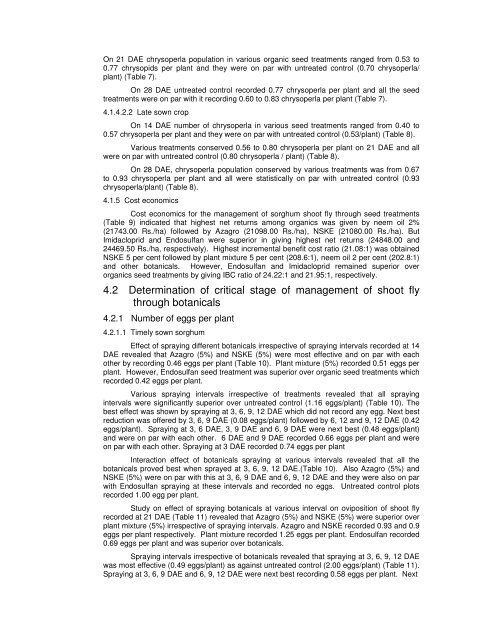NON-CHEMICAL APPROACHES FOR THE MANAGEMENT OF ...
NON-CHEMICAL APPROACHES FOR THE MANAGEMENT OF ...
NON-CHEMICAL APPROACHES FOR THE MANAGEMENT OF ...
You also want an ePaper? Increase the reach of your titles
YUMPU automatically turns print PDFs into web optimized ePapers that Google loves.
On 21 DAE chrysoperla population in various organic seed treatments ranged from 0.53 to<br />
0.77 chrysopids per plant and they were on par with untreated control (0.70 chrysoperla/<br />
plant) (Table 7).<br />
On 28 DAE untreated control recorded 0.77 chrysoperla per plant and all the seed<br />
treatments were on par with it recording 0.60 to 0.83 chrysoperla per plant (Table 7).<br />
4.1.4.2.2 Late sown crop<br />
On 14 DAE number of chrysoperla in various seed treatments ranged from 0.40 to<br />
0.57 chrysoperla per plant and they were on par with untreated control (0.53/plant) (Table 8).<br />
Various treatments conserved 0.56 to 0.80 chrysoperla per plant on 21 DAE and all<br />
were on par with untreated control (0.80 chrysoperla / plant) (Table 8).<br />
On 28 DAE, chrysoperla population conserved by various treatments was from 0.67<br />
to 0.93 chrysoperla per plant and all were statistically on par with untreated control (0.93<br />
chrysoperla/plant) (Table 8).<br />
4.1.5 Cost economics<br />
Cost economics for the management of sorghum shoot fly through seed treatments<br />
(Table 9) indicated that highest net returns among organics was given by neem oil 2%<br />
(21743.00 Rs./ha) followed by Azagro (21098.00 Rs./ha), NSKE (21080.00 Rs./ha). But<br />
Imidacloprid and Endosulfan were superior in giving highest net returns (24848.00 and<br />
24469.50 Rs./ha, respectively). Highest incremental benefit cost ratio (21.08:1) was obtained<br />
NSKE 5 per cent followed by plant mixture 5 per cent (208.6:1), neem oil 2 per cent (202.8:1)<br />
and other botanicals. However, Endosulfan and Imidacloprid remained superior over<br />
organics seed treatments by giving IBC ratio of 24.22:1 and 21.95:1, respectively.<br />
4.2 Determination of critical stage of management of shoot fly<br />
through botanicals<br />
4.2.1 Number of eggs per plant<br />
4.2.1.1 Timely sown sorghum<br />
Effect of spraying different botanicals irrespective of spraying intervals recorded at 14<br />
DAE revealed that Azagro (5%) and NSKE (5%) were most effective and on par with each<br />
other by recording 0.46 eggs per plant (Table 10). Plant mixture (5%) recorded 0.51 eggs per<br />
plant. However, Endosulfan seed treatment was superior over organic seed treatments which<br />
recorded 0.42 eggs per plant.<br />
Various spraying intervals irrespective of treatments revealed that all spraying<br />
intervals were significantly superior over untreated control (1.16 eggs/plant) (Table 10). The<br />
best effect was shown by spraying at 3, 6, 9, 12 DAE which did not record any egg. Next best<br />
reduction was offered by 3, 6, 9 DAE (0.08 eggs/plant) followed by 6, 12 and 9, 12 DAE (0.42<br />
eggs/plant). Spraying at 3, 6 DAE, 3, 9 DAE and 6, 9 DAE were next best (0.48 eggs/plant)<br />
and were on par with each other. 6 DAE and 9 DAE recorded 0.66 eggs per plant and were<br />
on par with each other. Spraying at 3 DAE recorded 0.74 eggs per plant<br />
Interaction effect of botanicals spraying at various intervals revealed that all the<br />
botanicals proved best when sprayed at 3, 6, 9, 12 DAE.(Table 10). Also Azagro (5%) and<br />
NSKE (5%) were on par with this at 3, 6, 9 DAE and 6, 9, 12 DAE and they were also on par<br />
with Endosulfan spraying at these intervals and recorded no eggs. Untreated control plots<br />
recorded 1.00 egg per plant.<br />
Study on effect of spraying botanicals at various interval on oviposition of shoot fly<br />
recorded at 21 DAE (Table 11) revealed that Azagro (5%) and NSKE (5%) were superior over<br />
plant mixture (5%) irrespective of spraying intervals. Azagro and NSKE recorded 0.93 and 0.9<br />
eggs per plant respectively. Plant mixture recorded 1.25 eggs per plant. Endosulfan recorded<br />
0.69 eggs per plant and was superior over botanicals.<br />
Spraying intervals irrespective of botanicals revealed that spraying at 3, 6, 9, 12 DAE<br />
was most effective (0.49 eggs/plant) as against untreated control (2.00 eggs/plant) (Table 11).<br />
Spraying at 3, 6, 9 DAE and 6, 9, 12 DAE were next best recording 0.58 eggs per plant. Next
















